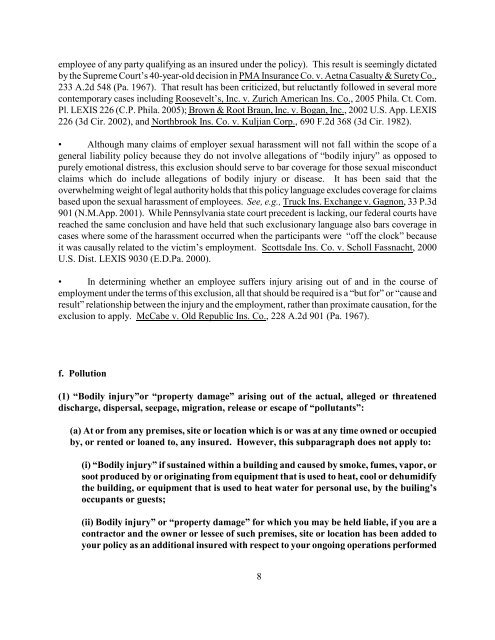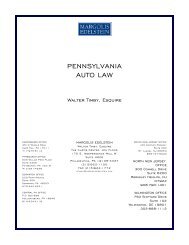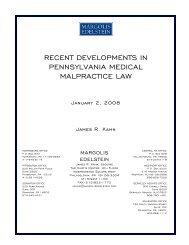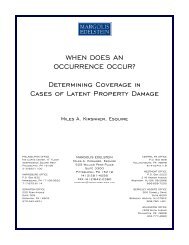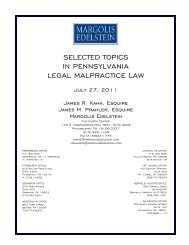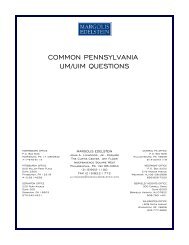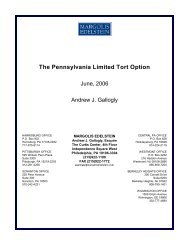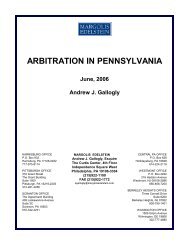Commercial General Liability Coverage Exclusions Under
Commercial General Liability Coverage Exclusions Under
Commercial General Liability Coverage Exclusions Under
Create successful ePaper yourself
Turn your PDF publications into a flip-book with our unique Google optimized e-Paper software.
employee of any party qualifying as an insured under the policy). This result is seemingly dictated<br />
by the Supreme Court’s 40-year-old decision in PMA Insurance Co. v. Aetna Casualty & Surety Co.,<br />
233 A.2d 548 (Pa. 1967). That result has been criticized, but reluctantly followed in several more<br />
contemporary cases including Roosevelt’s, Inc. v. Zurich American Ins. Co., 2005 Phila. Ct. Com.<br />
Pl. LEXIS 226 (C.P. Phila. 2005); Brown & Root Braun, Inc. v. Bogan, Inc., 2002 U.S. App. LEXIS<br />
226 (3d Cir. 2002), and Northbrook Ins. Co. v. Kuljian Corp., 690 F.2d 368 (3d Cir. 1982).<br />
• Although many claims of employer sexual harassment will not fall within the scope of a<br />
general liability policy because they do not involve allegations of “bodily injury” as opposed to<br />
purely emotional distress, this exclusion should serve to bar coverage for those sexual misconduct<br />
claims which do include allegations of bodily injury or disease. It has been said that the<br />
overwhelming weight of legal authority holds that this policy language excludes coverage for claims<br />
based upon the sexual harassment of employees. See, e.g., Truck Ins. Exchange v. Gagnon, 33 P.3d<br />
901 (N.M.App. 2001). While Pennsylvania state court precedent is lacking, our federal courts have<br />
reached the same conclusion and have held that such exclusionary language also bars coverage in<br />
cases where some of the harassment occurred when the participants were “off the clock” because<br />
it was causally related to the victim’s employment. Scottsdale Ins. Co. v. Scholl Fassnacht, 2000<br />
U.S. Dist. LEXIS 9030 (E.D.Pa. 2000).<br />
• In determining whether an employee suffers injury arising out of and in the course of<br />
employment under the terms of this exclusion, all that should be required is a “but for” or “cause and<br />
result” relationship between the injury and the employment, rather than proximate causation, for the<br />
exclusion to apply. McCabe v. Old Republic Ins. Co., 228 A.2d 901 (Pa. 1967).<br />
f. Pollution<br />
(1) “Bodily injury”or “property damage” arising out of the actual, alleged or threatened<br />
discharge, dispersal, seepage, migration, release or escape of “pollutants”:<br />
(a) At or from any premises, site or location which is or was at any time owned or occupied<br />
by, or rented or loaned to, any insured. However, this subparagraph does not apply to:<br />
(i) “Bodily injury” if sustained within a building and caused by smoke, fumes, vapor, or<br />
soot produced by or originating from equipment that is used to heat, cool or dehumidify<br />
the building, or equipment that is used to heat water for personal use, by the builing’s<br />
occupants or guests;<br />
(ii) Bodily injury” or “property damage” for which you may be held liable, if you are a<br />
contractor and the owner or lessee of such premises, site or location has been added to<br />
your policy as an additional insured with respect to your ongoing operations performed<br />
8


